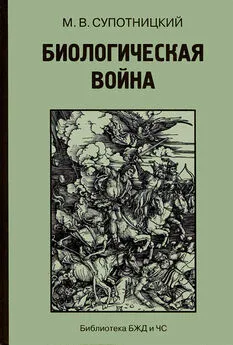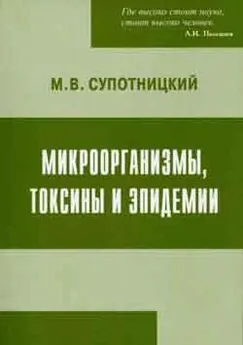Михаил Супотницкий - Биологическая война (Часть 3)
- Название:Биологическая война (Часть 3)
- Автор:
- Жанр:
- Издательство:Кафедра, Русская панорама
- Год:2013
- Город:Москва
- ISBN:978-5-93165-328-0
- Рейтинг:
- Избранное:Добавить в избранное
-
Отзывы:
-
Ваша оценка:
Михаил Супотницкий - Биологическая война (Часть 3) краткое содержание
Часть 3. Частная неправильная эпидемиология.
Биологическая война (Часть 3) - читать онлайн бесплатно полную версию (весь текст целиком)
Интервал:
Закладка:
Amon S. S., Schechter R., Inglesby Т. V. et al. Botulinum toxin as a biological weapon: medica, and public health management // JAMA. 2001. V. 285. № 8. P. 1059–1070 (doi: 10.1001/jama 285.8.1059).
African-Bouvety N., RodolakisA. Is Q fever an emerging or re-emerging zoonosis? // Vet. Res. 2005. V. 36. P. 327–349.
Atkins L. C., Crossman Т., Pitt C. et al. Genomic plasticity of the causat.ve agent of melioidosis, Burkholderia pseudomallri // Proc. Natl. Acad Sci. USA. 2004 V. 101 P. 14240—1^245
Audi J., Behon M. et al. Ricin poisoning. A comprehensive review // JAMA. 2005. V. 294. JSfe 18. P. 2343–3251.
Baca O. G., Paretsky D. Q fever and Coxiella burnetii: a model for host-parasite interactions // Microbiol. Rev. 1983. V. 47. P. 127–149.
Balder R., Lipski S., Lazarus J. et al. Identification of Burkholderia mallei and Burkholderia pseudomallei adhesins for human respiratory epithelial cells // BMC Microbiology. 2010. V. 10. № 250 (http://www.biomedcentral.com/1471-2180/1u/250).
Baltz R. H. Antimicrobials from Actinomycetes: back to the future // Am. Soc. Microbiol. 2007. V. 2. P. 125–131.
Banerjee R. Nanoparticle aerosols boon or bane for breathing? // Nanomedicine. 2012. V. 7, № 6.795–798.
Barakat L. A., Quentzel H. L., Jernigan J. A. et al. Woman fatal inhalational anthrax in a 94-year-old Connecticut // JAMrt 2002. V. 287. Mb 7. p. 863–868
Baron G. S., Nano F. E. MgIA and MgIB are required for the intramacrophage growth of Francisella novicida // Mor. Microbiol. 1998. V. 29 P. 247–259
Barrett A. D. Т., Gould A. Antibody-mtdiated early death in vivo after infection with Yellow fever virus // J-Gen. Virol 1986, V. 67. P. 2539–2542.
Barth H, Aktories K., Popoff M. R. et al. Binary bacterial toxins: biochemistry, biology, and applications of common Clostridium and Bacillus proteins // Microbiol. Mol Biol. Rev. 2004. V. 68, № 3. P. 373–402.
Bobkerville A., Bowen E. T. W, PlattG.S.et al. The pathology ofexperimental Ebola virus infection in monkeys // J. Pathol. 1978. V. 125. № 3 P. 131–138.
Batzaroff A. La pneumonie pesteuseexperimentale // Ann. Inst. Pasteur. 1899. V. 13 P. 385–405.
Bausch D. G., SprecherA G, Jeffs B. et al. Treatment of Marburg and Ebola hemorrhagic fevers A shategy for testing new drugs and vaccines under outbreak conditions // Antiviral Res. 2008. V. 78/ № 1. P. 150–161.
Baykam N., Ergonul O., Ulu A. et al. Characteristics of cutaneous anthrax in Turkey // J. Infect. Dev. Ctries. 2009. V. 3. № 8. P. 599–603.
Beare P. A., Samuel J. E., Howe D. et al. Genetic diversity of the Q fever agent, Coxiella burnetii, assessed by microarraj — based whole-genome comparisons // J. Bacteriol. 2006. V. 188 № 7. P. 2309–2324
Beare P. A., Sandoz K. М., Omsland A. Advances in genetic manipulation of obligate intracellular bacterial pathogens // Frontiers in Microbiology. 2011. V 2. Article 97 (doi: 10.3389/fmicb. 2011.00097)
Beare P., Howe D., Cockrell D. et al. Characterization of a Coxiella burnetii fts Z mutant generated by Himar1 transposon mutagenesis // J. Bacteriol. 2009 V 191. № 5. P. 1369–1381.
Beckett B. Weapons of Tomorrow. N. Y., 1982.
Beghr E. M., Asiki G., Anywame Z. et al. Pneumonic plague cluster, Uganda, 2004 // Emerg. Infect. Die. 2006. V. 12. № 3. P. 460–467.
Bell D. М., Kozarsky Ph. E., Stephens D. S. Clinical issues in the prophylaxis, diagnosis and treatment ol anthrax // Emeig. Infect. Dis. 2002. V. 8. № 2 P. 222–225.
Bemoridge G. P., Lopez J. A., Cook R. et at Recombinant vaccinia virus coexpressing the F protein of respiratory syncytial virus (RSV) and interleukin-4 (IL-4) does not inhibit the development of RSV-specific memory cytotoxic T lymphocytes whereas priming Is diminished in the presence of high levels of IL-2 or gamma interferon // J. Virol. 1998. V. 72. № 5. P. 4080–4087.
Benarroch D., Claverie J. M. kaouit D. et aI Characterization of mimivirus DNA tope isomerase IB suggests horizontal gene transfer between eukaryal viruses and bacteria // J. Virol. 2006. V. 80. P. 314–321.
Benedek C., Rivier L. Evidence for the presence of tetrodotoxin in a powder used in Haiti for zombification // Toxicon. 1989. V. 27. № 4. P. 473–480.
Benenson A.S., Tigera W. D. Studies on Q. fever in man // Trans. Assoc. Am. Physicians. 1956. V. 69. P. 98—104.
Bennett J. W., Klich M. Mycotoxms // Clin. Microbiol. Rev. 2003. V. 16. №. 3. P. 497–516.
Bennett P. M. Integrons and gene cassettes: a genetic construction kit for bacteria // J. Antimicrob. Chemother. 1999. V. 43 P. 1–4.
Bennett P. M. Plasmid encoded antibiotic resistance: acquisition and transfer of antibiotic resistance genes in bacteria // Brit. J. Pharmacol. 2008. V. 153. S347—S357.
Berdal B. P., Mehl R., Meldell N. K. et al. Field investigations of tularemia in Norway // FEMS Immunol. Med. Microbiol. 1996. V. 13. P. 191–195.
Bergen J. М., Park In-Kvu, Horner P. J. et al. Nonviral approaches for neuronal delivery of nucleic acids // Phar. Res. 2008. V. 25. № 5. P. 983 998.
Bergen J. М., Pun S. H. Evaluation of an LC8-binding peptide for the attachment of artificial cargo.o dynein Ц Mcl. Phami. 2007. V. 4. P. 119–128
Bernhard K., Schrempf II., Goebel W. Bacteriocin and antibiotic resistance plasmids in Bac.llus cereus and Bacillus subtil» // J- Bacteriol. 1978. V. 133. № 2. P. 897–903.
Bernstein B. J. America’s biological warfare program in the Second World War // J. Strateg. Stud. 1988. V 11. № 2. P. 292–317.
Berry B., Barrett I… Seymour L.etal Gene therapy for central nervous system repair // Curr. Opin, Mol. Ther. 2001. V 3. P. 338–349.
Bhakdi S., Bayley H. et al. Staphylococcalalpha-toxin, stmptolysin-0 and Escherichiacolihemolysin: prototypes of pore-forming bacterial cytolysins // Arch. Microbiol. 1996. V. 165 № 1. P. 73–79.
Bhakdll S., Tranum-Jensen J. Alpha-toxin of Staphylococcus aureus // Microbiol. Rev. 1991. V. 55. № 4. P. 733–751.
Bharuli D. J., Klejbor I., Stachowiak E. et al. Oigamcally modified silica nanoparticles: a nonviral vectoi for in vivo gene delivery and expression in the brain // Proc Natl. Acad. Sci. USA. 2005. V 102 P. 11539-11544.
Bhatia К P., Miinchau A., Thompson P. D et al. Generalised muscular weakness after botulinum toxin injections for dystonia: a report of three cases // J. Neurol. Neurosmg Psychiatry. 1999. V. 67. P. 90–93.
Bhatnagar V.. Stoto М., Morton S. et al. Transmission patterns of smallpox: systematic review of natural outbreaks in Europe and North America since World Whi II // BMC Public Health. 2006. V. 6. № 126 (http://www.biomedcentral com/1471-2458/6/126).
Bienkowska-Szewczyk K., Szewczyk В Expression of genes coding for viral glycoproteins in heterologous systems // Acta Biochimica Polomca. 1999. V. 46. № 2. P. 325–339.
Bigalke H., Rummel A. Medical aspects of toxin weapons // Toxicol. 2005. V. 214. P. 210–220.
Black J. L. Genome projects and gene therapy gateways to next genet ation biological weapons // Milit Med. 2003 V 108. № 11. P. 864–871
Blum G., lalbo V., Capnuli A. et al. Gene clusters encoauig the cytotoxie necrotizing factor type 1, Prs-fimbriae and — hemolysin form the pathogenicity island II of the uropathogenic Escherichia coli strain J96 // FEMS Microbiol. Lett 1995. V. 126 № 1. P. 189–196.
Boado R.J, Pardridge W. M. The Trojan horse liposome technology for nonviral gene transfer across the Llood-brain barrier // J. of Drug Deliv. 2011. rdoulO.l 155/2011/296151).
Bodian D. Howe H. A. Experimental studies on intraneural spread of poliomyelitis virus // Bull. J. Hopkins Hosp. 1941. V. 69. P. 248–267.
BoeckleS., Wagner E. Optimi2 ng targeted gene delivery: chemical modification of viral vectors and synthesis of artificial virus vector systems // AAPSJ. 2006. V 8. № 4. P. 731–742.
Bonner J. S. Nanoparticles as a potential cause of pleural and interstitial lung disease // Proc. Am. Thorac. Soc. 2010. V. 7. P. 138–141
Borio L., lriglesby T, Peters C. J. et al. Hemorrhagic fever viruses as biological weapons. Medical and public health management // JAMA. 2002. V. 287. № 18. P. 2391–2405.
Borison Н. L., Culp W. J., Gonsalves S. F. ei al. Central respiratory and circulatory depression caused by intra-vaxuiar saxitoxin // Br. J. Pharmac. 1980. V. 68. P. 301–309.
Bonn P., Robbins D., Haubold S. The potential risks of nanomaterials: a review canied out for ECETOC // Panicle and Fibre Toxicology. 2006. V. 3. (http://www.particleandfibretoxxology.com/content/3/1/11).
Bossi P, Tegnell A, Baka A et al. Bichat guidelines for the clinical management of haemorrhagic fever viruses and bioterrorism-related haemorrhagic fever viruses // Euro Surveill. 2004. V. 9. № 12 (http://www.eurosurveillance.org/em/v09nl2/0912-235.asp).
Bowen J. E., Quinn C. P. The native virulence plasmid combination affects the segregational stability of a theta-repLcating shuttle vector in Bacillus anthrocisvar. New Hampshire // J. Appl. Microbiol 1999. V. 87 № 2. P. 270–278,
Bowen M. D., Rollin P. E., Ksiazek T. G. et al. Genetic diversity among Lassa virus strains // J. Virol. 2000. V 74. № 15. P. 6992–7004.
Brachman P. S., Kaufmann A. F., DalldoreF. Industrial inhalation anthrax // Bacteriol. Rev. 1966. V. 30. № 3. P. 646–657.
Braude A. I., DavisC. E., FiererJ. F. Infectious diseases and medical rnicrob.ology. W. B. Saunders Company, Philadelphia, 1986.
Bravo A., Gymez I., Conde J. et al. Oligomerization triggers binding of a Bacillus thuringiensis Cry 1 Ab pore-formiiig toxin to amlnopeptidase N receptor leading to insertion into membrane microdomains // Biochim. Biophys. Acta. 2004. V. 1667. P. 38–46.
Bray M., Paraga., J. Experimental therapy of filovirus infections // Antiviral.Res.200? V. 54. № 1. P. 1—17.
Brett P. J., Mah D. C., Woods D. E. Isolation and characterization of Pseudomonas pseudomalici flagehin proteins // Infect. Immun. 1994. V. 62. P. 1914–1919.
Brett P., Burtnick M.R., Snyder S. et al. Burkholderia mallei expresses a unique lipopolysaccharide mixture that is a potent activator of human Poll-like receptor 4 complexes human Toll-like receptor 4 complexes // Mol. Microbiol. 2007 V. 63. № 2. P. 379–390.
Brotcke A., Monack D. M. Identification of fevR, a novel regulator of virulence gene expression in Francisella novicida // Infect. Immun. 2008. V. 76. P. 3473–3480.
Brotcke A., Weiss D. S., Kim C. C. et al. Identification of MgIA-regulated genes reveals novel virulence factors in Francisella tuiarensis // Infect. Immun. 2006. V. 74. P. 6642—6655
Brown D. М., Wilson M. R., MacNee W. et al. Size-dependent pruiiiflamnatory effects of uhra fine poly-styrene particles: a role for surface area and oxidative stress.n the enhanced activity of ultraftnes // Toxicol. App] Pharmacol. 2001. V. 175. P. 191–199.
Brown R. F. R., White D E. Ultrastructure of rat lung following inhalation of ricin aerosol // Int. J. Exp. Pathol. 1997. V, 78. № 4. P. 267–276.
Brussow H., Canchaya C., Wolf-Dietrich H. Pnages and the evolution of bacterial pathogens: from genomic rearrangements to lysogenic conversion // Microbiol Molecular. Biol. Rev. 2004. V, 68. № 3 P, 560–602.
Читать дальшеИнтервал:
Закладка:







![Михаил Супотницкий - Очерки истории чумы. Книга II. Чума бактериологического периода [без иллюстраций]](/books/1084186/mihail-supotnickij-ocherki-istorii-chumy-kniga-ii.webp)
![Михаил Супотницкий - Очерки истории чумы. Книга I. Чума добактериологического периода [без иллюстраций]](/books/1084187/mihail-supotnickij-ocherki-istorii-chumy-kniga-i-ch.webp)

